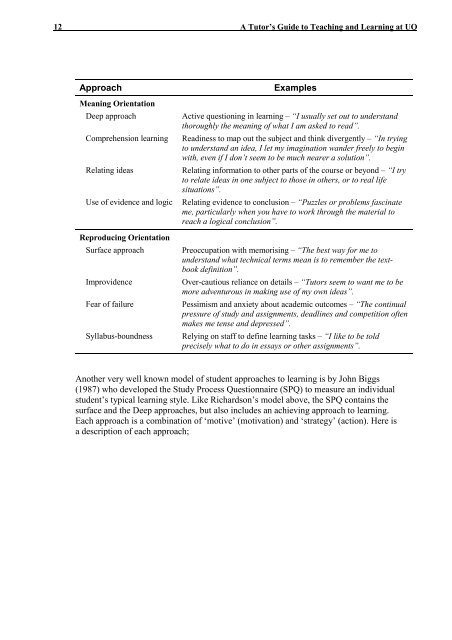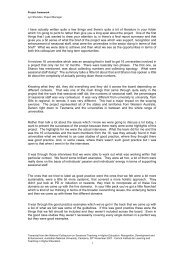12 A Tu<strong>to</strong>r’s Guide <strong>to</strong> Teaching <strong>and</strong> Learning <strong>at</strong> <strong>UQ</strong>ApproachMeaning Orient<strong>at</strong>ionDeep approachComprehension <strong>learning</strong>Rel<strong>at</strong>ing ideasUse <strong>of</strong> evidence <strong>and</strong> logicReproducing Orient<strong>at</strong>ionSurface approachImprovidenceFear <strong>of</strong> failureSyllabus-boundnessExamplesActive questioning in <strong>learning</strong> – “I usually set out <strong>to</strong> underst<strong>and</strong>thoroughly the meaning <strong>of</strong> wh<strong>at</strong> I am asked <strong>to</strong> read”.Readiness <strong>to</strong> map out the subject <strong>and</strong> think divergently – “In trying<strong>to</strong> underst<strong>and</strong> an idea, I let my imagin<strong>at</strong>ion w<strong>and</strong>er freely <strong>to</strong> beginwith, even if I don’t seem <strong>to</strong> be much nearer a solution”.Rel<strong>at</strong>ing inform<strong>at</strong>ion <strong>to</strong> other parts <strong>of</strong> the course or beyond – “I try<strong>to</strong> rel<strong>at</strong>e ideas in one subject <strong>to</strong> those in others, or <strong>to</strong> real lifesitu<strong>at</strong>ions”.Rel<strong>at</strong>ing evidence <strong>to</strong> conclusion – “Puzzles or problems fascin<strong>at</strong>eme, particularly when you have <strong>to</strong> work through the m<strong>at</strong>erial <strong>to</strong>reach a logical conclusion”.Preoccup<strong>at</strong>ion with memorising – “The best way for me <strong>to</strong>underst<strong>and</strong> wh<strong>at</strong> technical terms mean is <strong>to</strong> remember the textbookdefinition”.Over-cautious reliance on details – “Tu<strong>to</strong>rs seem <strong>to</strong> want me <strong>to</strong> bemore adventurous in making use <strong>of</strong> my own ideas”.Pessimism <strong>and</strong> anxiety about academic outcomes – “The continualpressure <strong>of</strong> study <strong>and</strong> assignments, deadlines <strong>and</strong> competition <strong>of</strong>tenmakes me tense <strong>and</strong> depressed”.Relying on staff <strong>to</strong> define <strong>learning</strong> tasks – “I like <strong>to</strong> be <strong>to</strong>ldprecisely wh<strong>at</strong> <strong>to</strong> do in essays or other assignments”.Another very well known model <strong>of</strong> student approaches <strong>to</strong> <strong>learning</strong> is by John Biggs(1987) who developed the Study Process Questionnaire (SPQ) <strong>to</strong> measure an individualstudent’s typical <strong>learning</strong> style. Like Richardson’s model above, the SPQ contains thesurface <strong>and</strong> the Deep approaches, but also includes an achieving approach <strong>to</strong> <strong>learning</strong>.Each approach is a combin<strong>at</strong>ion <strong>of</strong> ‘motive’ (motiv<strong>at</strong>ion) <strong>and</strong> ‘str<strong>at</strong>egy’ (action). Here isa description <strong>of</strong> each approach;
Section 2: Underst<strong>and</strong>ing Student Learning 13Approach Motive Str<strong>at</strong>egySurface Extrinsically motiv<strong>at</strong>ed –(<strong>of</strong>ten <strong>to</strong> avoid failure) byassessment requirements<strong>and</strong> the need <strong>to</strong> ‘pass’,seeing study as a means<strong>to</strong> an end such as a job,balancing not working<strong>to</strong>o hard with passing.Deep Intrinsically motiv<strong>at</strong>ed –usually <strong>to</strong> s<strong>at</strong>isfy personalcuriosity <strong>and</strong> interest inthe <strong>to</strong>pic.Focuses <strong>of</strong>ten on only the bare essentials, the facts<strong>and</strong> details (r<strong>at</strong>her than making connections betweenthem <strong>and</strong> seeing the structure <strong>of</strong> wh<strong>at</strong> is beinglearned), in order <strong>to</strong> reproduce the inform<strong>at</strong>ionaccur<strong>at</strong>ely, <strong>and</strong> <strong>of</strong>ten use memorising str<strong>at</strong>egies.They aim <strong>to</strong> meet assessment requirements but <strong>of</strong>tenonly <strong>to</strong> minimum st<strong>and</strong>ards, <strong>and</strong> appear <strong>to</strong> befocused on passing the assessment instead <strong>of</strong><strong>learning</strong> <strong>and</strong> underst<strong>and</strong>ing.Aim <strong>to</strong> maximise their own underst<strong>and</strong>ing <strong>of</strong>concepts, <strong>and</strong> make sense <strong>of</strong> wh<strong>at</strong> they are <strong>learning</strong>.They read widely, discuss ideas with others, reflec<strong>to</strong>n different perspectives, rel<strong>at</strong>ing ideas <strong>to</strong>gether <strong>and</strong>making connections with previous experiences.Achieving orStr<strong>at</strong>egicMotiv<strong>at</strong>ed <strong>to</strong> achieveacademically, <strong>of</strong>tenlinked <strong>to</strong> ego <strong>and</strong> selfesteem,<strong>and</strong> wish <strong>to</strong>obtain high grades orotherrewards/recognition.Optimise their organis<strong>at</strong>ion <strong>of</strong> time <strong>and</strong> effort <strong>and</strong>choose the most efficient <strong>and</strong> effective str<strong>at</strong>egy forparticular tasks (while memorising is <strong>of</strong>tenconsidered a surface str<strong>at</strong>egy, it depends on theintention, <strong>and</strong> is <strong>of</strong>ten a part <strong>of</strong> the achievingapproach if the most efficient <strong>and</strong> effective way <strong>of</strong><strong>learning</strong> the particular m<strong>at</strong>erial).They identify the assessment criteria <strong>and</strong> estim<strong>at</strong>e the<strong>learning</strong> effort required <strong>to</strong> achieve a particular grade.Often follow up all suggested readings/exercises,scheduling time <strong>and</strong> organising workspace.Studies <strong>of</strong> student <strong>learning</strong> show th<strong>at</strong> <strong>of</strong>ten the approach adopted by students is stronglyinfluenced by fac<strong>to</strong>rs in the environment, the <strong>teaching</strong> method, or the n<strong>at</strong>ure <strong>of</strong> thesubject, such as the type <strong>of</strong> assessment used, the workload required, feedback received,the enthusiasm <strong>of</strong> the teacher, or a large amount <strong>of</strong> content <strong>to</strong> be covered in the subject(e.g. first year biology or chemistry).Research also shows th<strong>at</strong> the <strong>learning</strong> approach adopted by students is <strong>of</strong>ten closelyrel<strong>at</strong>ed <strong>to</strong> the quality <strong>of</strong> their <strong>learning</strong> <strong>and</strong> their academic achievement – students whohave a surface approach <strong>to</strong> <strong>learning</strong>, being extrinsically motiv<strong>at</strong>ed <strong>and</strong> focussed on facts<strong>and</strong> details r<strong>at</strong>her than underst<strong>and</strong>ing <strong>and</strong> rel<strong>at</strong>ing concepts, <strong>and</strong> developing an interestfor in wh<strong>at</strong> is being learned, will normally achieve a lower quality <strong>learning</strong> outcome.Teachers can influence these fac<strong>to</strong>rs <strong>to</strong> varying degrees. For example, we c<strong>and</strong>iscourage disinterest <strong>and</strong> extrinsic motiv<strong>at</strong>ion, <strong>and</strong> encourage intrinsic interest bysharing our own passion <strong>and</strong> enthusiasm for the subject, emphasising its relevance <strong>to</strong>their overall program <strong>of</strong> study <strong>and</strong> their career goals, particularly in designinginteresting activities <strong>and</strong> assessment tasks th<strong>at</strong> help students <strong>to</strong> make connectionsbetween the subject <strong>and</strong> the 'real world' <strong>of</strong> work or the pr<strong>of</strong>ession.



